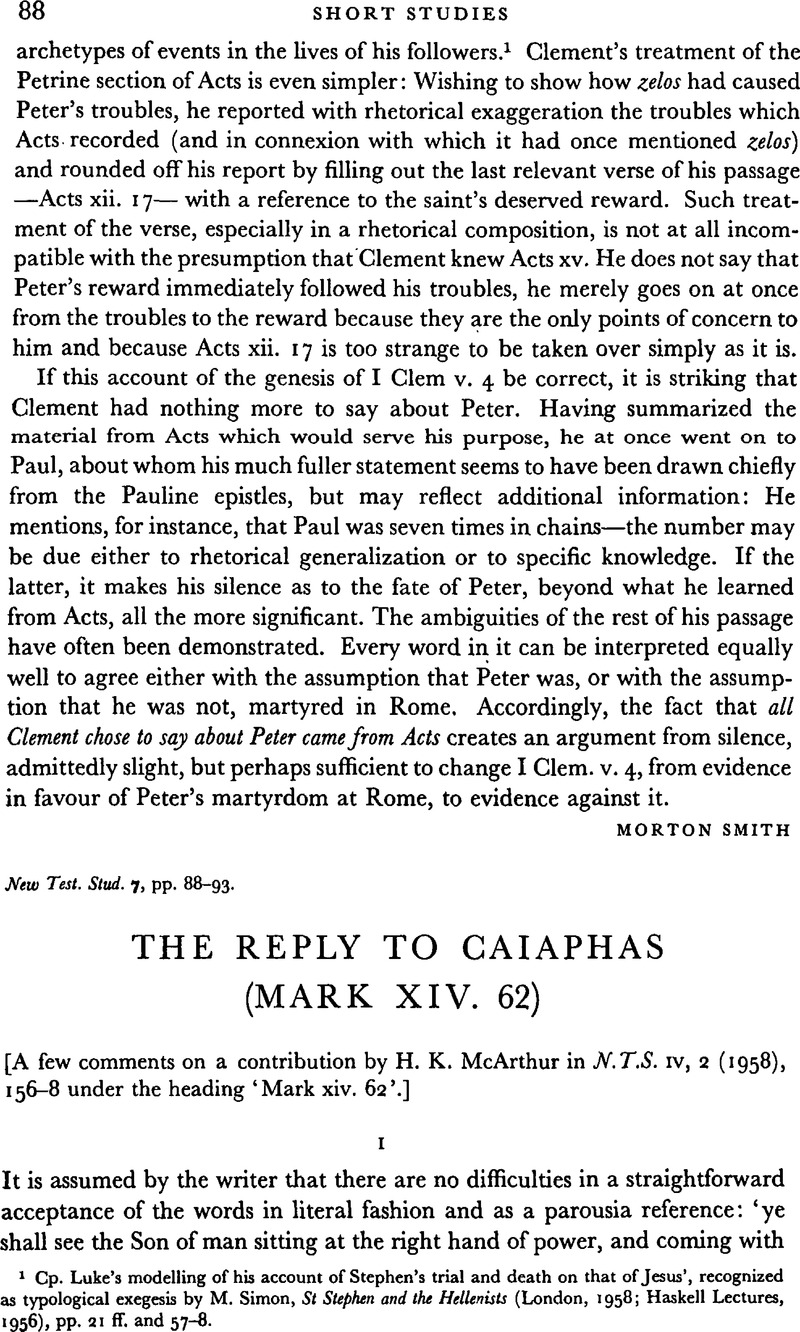Article contents
The Reply to Caiaphas (Mark xiv. 62)
Published online by Cambridge University Press: 05 February 2009
Abstract

- Type
- Short Studies
- Information
- Copyright
- Copyright © Cambridge University Press 1960
References
page 88 note 1 Cp. Luke's modelling of his account of Stephen's trial and death on that of Jesus', recognized as typological exegesis bySimon, M.Google ScholarSt Stephen and the Hellenists(London, 1958;Haskell Lectures,1956), PP. 21 ff. and 57–8.Google Scholar
page 1 note 1 Lohmeyer, E. at least saw the difficulty: ‘…es schwer möglich ist, das “Sitzen” zur Seite Gottes und das Kommen auf Wolken sich gleichsam uno intuitu vorzustellen.’Google Scholar
page 1 note 2 Bruston, C. gave a similar interpretation in ‘L’enseignement de Jésus sur son retour’, Revue de théologie et de philosophie (1890), pp. 145 ff., 344 ff., 421 ff. On Matt. xxvi. 64 he writes: ‘Prétendre… que dés maintenant se rapporte seulement à la séance à Ia droite de Dieu et non à la venue glorieuse, est une échappatoire vraiment indigne d'un exégète un peu sérieux’ (p. 154 n).Google Scholar
page 1 note 3 See also Temple's, W. posthumous volume, a collection of essays and addresses, edited by Baker, A. E., Religious Experience, p. 227.Google Scholar
page 1 note 1 N. Nisbett, Triumphs of Christianity over Infidelity (1802), pp. 150 f.Google Scholar Cf. on the meaning of the clouds Chandler, E., Defence of Christianity (1725; p. 108 in 3rd ed. 1728).Google Scholar
page 1 note 2 Cf. Klein, F.: ‘La conclusion à tirer des deux premiers évangiles est claire et ne peut donner lieu á aucune contestation: Ia venue sur les nuées du ciel…et la séance á la droite de Dieu…sont simultanées; l'avènement du Christ n'est pas une réalité future, elle a commencé dès après la mort du Sauveur’ (‘Remarques sur la Parousie’, Revue de théologie et de philosophie, 1950, pp. 105–11).Google Scholar
page 1 note 3 Lactantius (Institutes, IV, 21) regarded Dan. vii. 13 as a reference to the Ascension: ‘But when He had made arrangements with His disciples for the preaching of the Gospel and His name, a cloud suddenly surrounded Him, and carried Him up into heaven, on the fortieth day after His passion, as Daniel had shown that it would be, saying, “And behold one like the Son of man came with the clouds of heaven, and came to the Ancient of days”.’ Much better is the way in which Cyprian's Testimonies (11, 26) introduce the quotation under the heading, ‘That after He had risen again He should receive from His Father all power, and His power should be everlasting’; then follows Dan. vii. 13–14. E. B. Pusey in his Lectures on Daniel says that Dan. vii does not refer to the parousia, but to the presence of our Lord in heaven and his post-Resurrection reception of all power in heaven and earth (pp. 493 and 495, in 3rd ed. 1869).Google Scholar
page 1 note 1 ‘Als ob es glaublich wäre, daβ Jesus nicht das ganze gelesen und bedacht habe!’ (Kattenbusch, see below).Google Scholar
page 1 note 2 It may be found even in the same verse; cf. Gen. xlvi. 4 where ‘thee’ (Jacob) refers first to the patriarch, then the nation, then (with theword ‘thine’) the patriarch again. As Rowley, H. H. says: ‘The group could be thought of as functioning through an individual member, who for the time being so completely represents it that lie became identical with it… There was a fluidity of thought which seems strange to us,.whereby the speaker could pass from the community to the individual who represented it, and from the individual back to the community, without any apparent consciousness of the transitions.’ Re-discovery of the Old Testament (London, 1946), p. 152.Google Scholar Cf. Manson, T. W., ‘The Son of man in Daniel, Enoch and the Gospels’, Bulletin of the John Rylands Library, XXXII (1950), 190 f.Google Scholar
page 1 note 3 ‘Vorab sah er sich als Individuum in der Gestalt des “Menschensohns”, er, Jesus von Nazareth, war der, den Daniel “auf den Wolken des Himmels” zu Gott (empor) getragen erblickte.’Google Scholar
page 1 note 1 ‘…nicht nur das, was er individuell in sich barg, den persönlichen “Sohn” Gottes, sondern den “Reprasentanten”, den berufenen Herrn eines besonderen “Volks”, des Volks der Heiligen.’Google Scholar
page 1 note 2 This would harmonize well with the footnote on Matt. xxvi. 64 to be found in the Jerusalem Bible (1956): ‘Les Juifs ne le verront plus désormais que dans sa gloire, d'abord par le triomphe de la Résurrection, ensuite par celui de l'Église.’Google Scholar
page 1 note 3 That Caiaphas could not be expected to understand it fully is perfectly true. In his state of mind he would be unable (because unwilling) to understand any claim that Jesus made. To those without, all things are in riddles (Mark iv).Google Scholar
page 1 note 1 It should be noted that the words of Mark xiv. 62, ‘coming with the clouds of heavn’, are from Daniel and do not occur in Enoch. A number of scholars date the Similitudes in the Christian era. It is interesting that among the fragments found in the Dead Sea caves the other parts of Enoch are represented, but no trace of the Similitudes has come to light (see Revue Biblique, LXIII, 1956, 60;Google Scholar and Milik, J. T., Dix Ans de Découvertes dans 1e Désert de Juda, Paris, 1957, pp. 30 f.).Google Scholar
- 1
- Cited by


